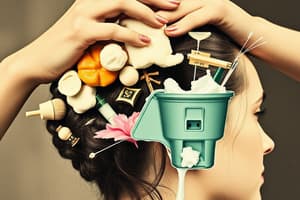Podcast
Questions and Answers
A young man shaving his head nicks his scalp and notices significant bleeding despite the small size of the wound. In which layer of the scalp are the blood vessels primarily located that would cause this?
A young man shaving his head nicks his scalp and notices significant bleeding despite the small size of the wound. In which layer of the scalp are the blood vessels primarily located that would cause this?
- Pericranium
- Dense connective tissue (correct)
- Skin
- Loose connective tissue
- Epicranial aponeurosis
Deep scalp lacerations tend to gape open widely. This is most likely because of the:
Deep scalp lacerations tend to gape open widely. This is most likely because of the:
- High density of collagen within the epidermal layer.
- Limited elasticity of the skin on the scalp.
- Pull of the frontalis and occipital bellies on the epicranial aponeurosis. (correct)
- Presence of numerous large veins in the loose connective tissue.
- Attachment of the scalp directly to the periosteum.
Following a head injury, a patient develops periorbital ecchymosis (black eye) but no direct trauma to the eye itself. Which of the following explains how the blood and fluid spread to the eyelids?
Following a head injury, a patient develops periorbital ecchymosis (black eye) but no direct trauma to the eye itself. Which of the following explains how the blood and fluid spread to the eyelids?
- Fluid tracks along the periosteum.
- The occipitofrontalis muscle attaches directly to the orbital bone.
- The occipitofrontalis muscle is attached to the skin and subcutaneous tissue and not to the bone. (correct)
- Direct spread through the zygomatic arch.
- The infection spreads through the loose connective tissue layer of the scalp.
During a surgical procedure near the ear, the facial nerve is inadvertently damaged near the stylomastoid foramen. Which muscle would be MOST affected by this injury?
During a surgical procedure near the ear, the facial nerve is inadvertently damaged near the stylomastoid foramen. Which muscle would be MOST affected by this injury?
Which of the following actions could be affected by damage to the temporal branch of the facial nerve?
Which of the following actions could be affected by damage to the temporal branch of the facial nerve?
Which of the following muscles is primarily responsible for compressing the cheeks, such as when pursing your lips or blowing air?
Which of the following muscles is primarily responsible for compressing the cheeks, such as when pursing your lips or blowing air?
A patient who has Bell's palsy exhibits paralysis of the orbicularis oculi muscle. What specific function of this muscle is MOST likely affected?
A patient who has Bell's palsy exhibits paralysis of the orbicularis oculi muscle. What specific function of this muscle is MOST likely affected?
Which muscle would be primarily responsible for the action of whistling?
Which muscle would be primarily responsible for the action of whistling?
What nerve provides motor innervation to the platysma muscle?
What nerve provides motor innervation to the platysma muscle?
Which of the following muscles elevates the upper lip?
Which of the following muscles elevates the upper lip?
The occipitalis muscle has which of the following actions?
The occipitalis muscle has which of the following actions?
In addition to the zygomatic branch, the orbicularis oculi receives nerve supply from which other branch?
In addition to the zygomatic branch, the orbicularis oculi receives nerve supply from which other branch?
The buccinator is unique in that it originates from which of the following structures?
The buccinator is unique in that it originates from which of the following structures?
Which of the following muscles is innervated by the facial nerve, and contributes to the formation of black eyes?
Which of the following muscles is innervated by the facial nerve, and contributes to the formation of black eyes?
Which muscle prevents the accumulation of food in the vestibule of the mouth?
Which muscle prevents the accumulation of food in the vestibule of the mouth?
Flashcards
Skin Layer of Scalp
Skin Layer of Scalp
The outermost layer of the scalp, containing hair follicles and sweat glands.
Connective Tissue Layer of Scalp
Connective Tissue Layer of Scalp
A dense layer of connective tissue in the scalp, containing nerves and blood vessels.
Aponeurosis Layer of Scalp
Aponeurosis Layer of Scalp
A strong, tendinous sheet in the scalp that connects the frontalis and occipitalis muscles.
Loose Connective Tissue Layer of Scalp
Loose Connective Tissue Layer of Scalp
Signup and view all the flashcards
Pericranium Layer of Scalp
Pericranium Layer of Scalp
Signup and view all the flashcards
Frontalis Muscle Action
Frontalis Muscle Action
Signup and view all the flashcards
Occipitalis Muscle Action
Occipitalis Muscle Action
Signup and view all the flashcards
Why Scalp Wounds Gape
Why Scalp Wounds Gape
Signup and view all the flashcards
Why Scalp Wounds Bleed Profusely
Why Scalp Wounds Bleed Profusely
Signup and view all the flashcards
Orbicularis Oculi Palpebral Part
Orbicularis Oculi Palpebral Part
Signup and view all the flashcards
Orbicularis Oculi Orbital Part
Orbicularis Oculi Orbital Part
Signup and view all the flashcards
Orbicularis Oculi Lacrimal Part
Orbicularis Oculi Lacrimal Part
Signup and view all the flashcards
Buccinator Action
Buccinator Action
Signup and view all the flashcards
Orbicularis Oris Action
Orbicularis Oris Action
Signup and view all the flashcards
Platysma Action
Platysma Action
Signup and view all the flashcards
Study Notes
Scalp
- The scalp extends posteriorly from the superior nuchal lines.
- The scalp extends anteriorly from the supraorbital margin of the frontal bone.
- The scalp extends laterally to the zygomatic arches.
Layers of the Scalp
- The layers of the scalp, from superficial to deep, are Skin, Connective tissue, Aponeurosis, Loose connective tissue, and Pericranium.
- The skin contains hair.
- The connective tissue contains the nerves and blood supply of the scalp.
- The aponeurosis contains the occipitofrontalis muscle.
- The loose connective tissue is a dangerous layer because it contains emissary veins, so infection here can reach the brain.
- The pericranium is the periosteum which is adherent to the bone.
Occipitofrontalis Muscle
- The frontalis part originates from the skin and superficial fascia of eyebrows and inserts into the aponeurosis.
- The frontalis part raises the eyebrows and moves the scalp forward.
- The occipitalis part originates from the superior nuchal line and inserts into the aponeurosis.
- The occipitalis moves the scalp backwards.
- Nerve supply: facial nerve.
Clinical Anatomy and Scalp Wounds
- Deep scalp wounds gape widely when the epicranial aponeurosis is lacerated in the coronal plane.
- This is due to the pull of the frontal and occipital bellies of the occipitofrontalis muscle in opposite directions.
- Reasons wounds bleed profusely:
- The scalp is highly vascular.
- Vessels lie superficially in the 2nd layer.
- Wound gaps.
- Vessel walls fail to retract.
Clinical Anatomy and Black Eyes
- An infection or fluid can enter the eyelids and root of the nose because the occipitofrontalis is attached to the skin and subcutaneous tissue and not to the bone.
Muscles of Facial Expression
- These muscles are derived from the 2nd pharyngeal arch.
- These muscles are supplied by the facial nerve.
Orbicularis Oculi
- Orbicularis oculi is composed of the orbital part, the palpebral part, and the lacrimal part.
- The orbital part is around the orbital margin and does a firm closure of the eye.
- The palpebral part is within the eyelids and does a gentle closure of the eye (sleep).
- The lacrimal part is in the free margin of the eyelid, around the lacrimal sac, and helps tear drainage.
- Nerve supply: temporal and upper zygomatic branches of the facial nerve.
Buccinator
- Origin: Maxilla opposite molar teeth, Mandible opposite molar teeth, Pterygomandibular ligament.
- Insertion is the upper and lower lips.
- Nerve supply: facial nerve.
- Action: Blowing.
- Action: Prevent accumulation of food in the vestibule of the mouth.
Orbicularis Oris
- In the lips.
- Surrounds the mouth.
- Nerve supply: facial nerve.
- Action: whistling and kissing.
Ear Muscles
- Auricularis anterior
- Auricularis superior
- Auricularis posterior
Platysma
- Origin: from the deep fascia and skin over pectoralis major and deltoid.
- Insertion: inferior border of the mandible, skin of the face inferior to the mouth.
- Nerve supply: Facial nerve.
- Action: Depresses the angle of the mandible.
- Action: Tenses the skin of the neck.
Facial Nerve Injury
- Injury to the facial nerve (CN VII) or its branches produces paralysis of some or all facial muscles on the affected side (Bell palsy).
- The affected area sags.
- Facial expression is distorted, making it appear passive or sad.
Studying That Suits You
Use AI to generate personalized quizzes and flashcards to suit your learning preferences.




